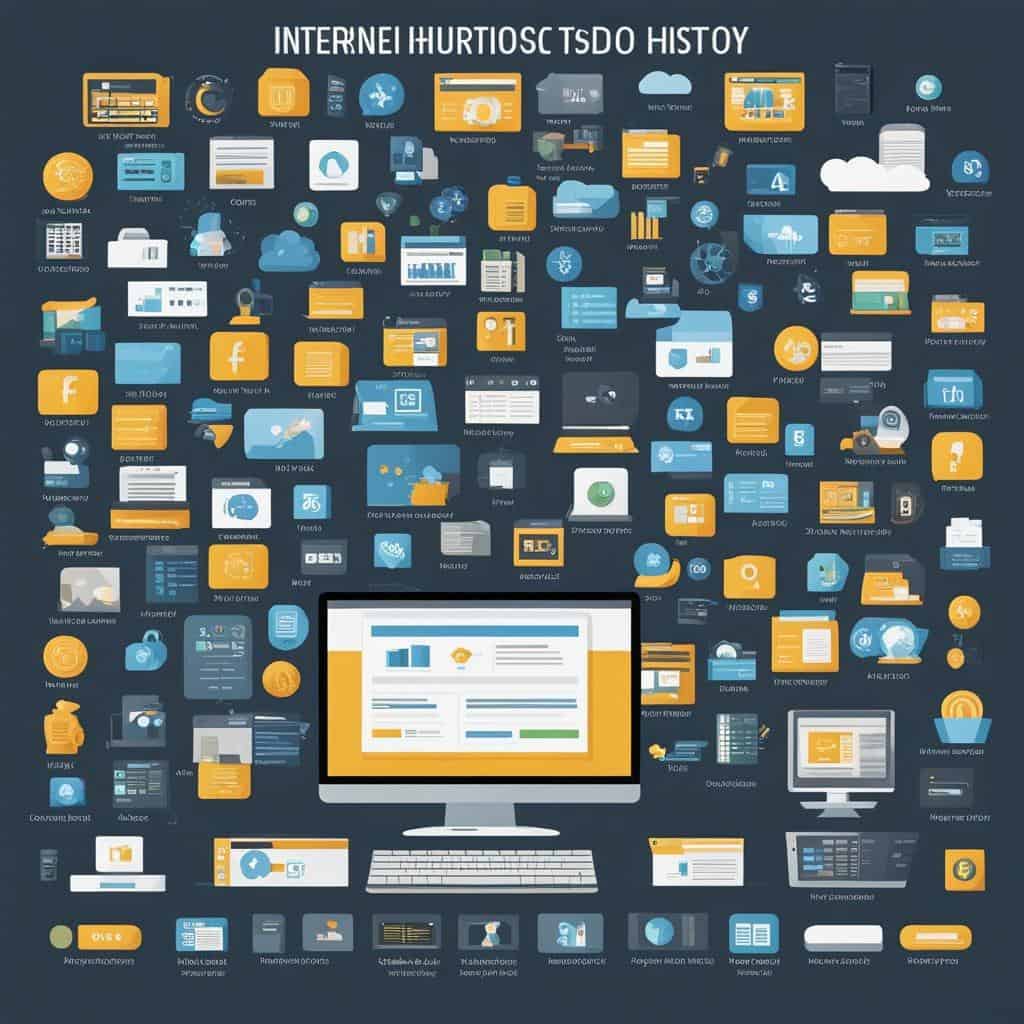TL;DR:
- The origins of the internet date back to the 1950s, primarily as a defense strategy by the USA in response to the Cold War. Key contributors include Lawrence Roberts, Paul Baran, Leonard Kleinrock, Donald Davies, Vint Cerf, and Bob Kahn.
- Technological innovations such as packet switching, TCP/IP, and the DNS system were vital to the evolution and growth of the Internet.
- ARPANET, the predecessor of the internet, played a crucial role in internet evolution by pioneering packet switching and TCP/IP, which revolutionized data transport.
- The Internet transitioned from government-controlled to public access through events like the rise of personal computers and the normalization of TCP/IP and DNS protocols.
- Tim Berners-Lee introduced concepts like hyperlinks, HTML, and URLs giving birth to the World Wide Web, which is a part of the larger Internet infrastructure.
- Internet browsing evolved from the first-ever web browser ‘WorldWideWeb’ created by Tim Berners-Lee to later browsers like Netscape Navigator and Internet Explorer which dramatically improved user experience.
- The internet has greatly impacted commerce and society, leading to the rise of e-commerce and facilitating globalization by eliminating geographical barriers.
- The future of the Internet might see significant advancements in technology and regulation, including Internet of Everything, Semantic Web, reinforced data privacy laws, and possibly quantum computing.
“Ever pondered the labyrinthine tale of the internet’s inception? Uncover an untold narrative bursting with Cold War intrigue, technological revolution, and unprecedented societal impacts in our deep dive into the fascinating history of internet technology. Buckle up and join us on this captivating journey that’s sure to light up your techie neurons!”
What were the Historical Origins of the Internet?
Let’s dive into the past. The history of internet technology is entwined with global politics. Back in the 1950s, Cold War fears spurred on the USA. They needed a system that could withstand Soviet attacks.
How Did the Cold War Influence the Emergence of the Internet?
Threats of Soviet nuclear attack inspired a new communication model. It was fault-tolerant and without a central hub that could be destroyed. This design led to the emergence of packet-switching networks in the USA.
Although we’re discussing a time of tension, it sparked innovation. Let’s look at the timeline of Internet beginnings. In 1957, the launch of Sputnik by the Soviet Union led to the creation of ARPA, a US defense agency. ARPANET, the father of the internet, was born from ARPA.
Who were the Key Players in the Development of the Internet?
The internet is a collage of brilliant minds. In 1965, Lawrence Roberts breathed life into the first computer network using a phone line. He, along with Paul Baran, Leonard Kleinrock, and Donald Davies laid the groundwork.
A key event on our internet inception dates timeline is the birth of TCP/IP. Credit for this goes to Vint Cerf and Bob Kahn. And we can’t forget Paul Mockapetris and Jon Postel creators of the DNS system. All these breakthroughs paved the way for the rapid growth of digital networks.
What Role Did ARPANET Play in the Internet’s Evolution?
ARPANET holds a special place in the story of the internet. This pioneering network began with just four computers located in separate research labs. But by 1981, it connected 213 computers and the number just kept growing. ARPANET introduced two crucial tools to the world – packet switching and TCP/IP. Together, these revolutionized data transport, remaining foundational to the internet we know today.
So, this historical journey may have been more exciting than you thought. Throughout our exploration of the history of the Internet, we’ve witnessed how world events shape technology, and how brilliant minds collaborate to change the world.

What were the Technological Innovations that Catalyzed the Growth of the Internet?
As we dig deeper into the history of the internet, let’s unravel the game-changing technologies that fueled its tremendous growth.
What is Packet Switching and How Did it Influence Internet Evolution?
Packet switching is a neat way of sending data. It divides the data into chunks or “packets”. Each packet can use a different route to reach its destination where all are reassembled. Cool, right? This smart system was vital to internet evolution. The internet uses it even today. It is efficient, reliable, and well, simply brilliant for managing network traffic.
How has TCP/IP Reformed Internet Functionality?
Let’s talk about TCP/IP next. It stands for Transmission Control Protocol and Internet Protocol. Imagine it like the rules of the road but for data moving on the internet. Not only does it ensure that data reaches the correct destination, but also keeps track of it. Now, every device gets a unique IP address, kind of like a house number. TCP/IP was a game-changer. Its use as a standard ironed out kinks in the system and gave the internet a real growth boost.
How Did the DNS System Simplify Internet Use?
Brace yourself for the next big thing. The Domain Name System or DNS. Consider it like your smartphone’s contact list. But instead of phone numbers, it matches website IP addresses with their domain names. So instead of typing a number string to visit a website, you just need to type its name. Easier? You bet! The DNS system has been a giant leap in simplifying internet use for everyone.
As we peel back more layers of internet history, one thing is clear. Its growth was driven not by a single innovation but by an incredible series of them. These technologies were the bricks that built the mighty edifice of the modern internet.
Undeniably, the story of the internet is more fascinating than we thought! The high-speed, seamless connectivity we enjoy today isn’t merely a product of chance, but a testament to decades of human ingenuity and relentless pursuit of progress.
How did the Internet Transition from Government-Controlled to Public Access?
The internet you know today was not always so user-friendly and accessible. Let’s journey back in time when it was still under government supervision.
What Events Led to the Democratization of Internet Access?
The internet’s roots trace back to the USA in the 1950s, during an era of Cold War tension. There was a shared need among researchers for a robust communication system that could resist potential attacks, which led to the creation of the Internet as we know it.
Fast-forward to around the 1970s, the rise of personal computers ignited public fascination with digital networks. But access to the internet remained a distant dream. It took a series of events, like the normalization of TCP/IP and Domain Name System (DNS) protocols to make the Internet public in the 1970s and 1980s.
Armchair programmers, hobbyists, and people enthusiastic about technology systems were among the first to experiment and explore the internet’s potential. This democratization process wasn’t fast – it took almost a decade for the Internet to become more accessible.
How did Dial-Up Internet Evolve into Broadband?
The first glimpse of internet access came with dial-up, connecting to the internet via telephone lines. But this journey was marked with growing pains. Compared to today’s broadband internet, dial-up was painfully slow, sometimes taking minutes to load a single web page. You could even be kicked offline when someone used the landline phone.
Despite the drawbacks, dial-up internet played an instrumental role as it kept people connected from their homes for the first time, leading to waves of innovation that brought us to the era of high-speed broadband internet we have today.
The transition from dial-up to broadband opened the doors of the internet to the masses. No longer restricted to school labs or corporate offices, the internet hooked up to home televisions and personal computers, bringing the world into living rooms and spawning the online culture we see today.
Broadband made it possible for everyone to stream video, shop online, and explore the limitlessness of the internet—changing the way we live, work, and play.

What were the Milestones in Internet Accessibility?
From government-controlled to dial-up and then to broadband, the public access history of the Internet is a tale of technology, perseverance, and great minds coming together.
And we cannot discuss internet milestones without mentioning the World Wide Web. In 1989, Tim Berners-Lee revolutionized the Internet by introducing concepts like hyperlinks, HTML, and URLs, distinguishing the Web from the underlying Internet infrastructure.
Eager to make the internet even more consumer-friendly, Marc Andreessen developed Netscape Navigator, the predecessor of today’s modern browsers. By the mid-1990s, Netscape Navigator was a global success with an estimated 10 million users worldwide.
The boom years of 1996 to 2000, known as the dot-com bubble, spurred the rise of online shopping and digital businesses. Though this era was marked by high-profile successes and dramatic failures, it planted the seeds for today’s thriving e-commerce industry.
So, as you see, the transition of the internet from a government-controlled tool to a household staple wasn’t easy or swift. But it was certainly fascinating, shaping the digital era we inhabit today. We can’t help but marvel at the pace of technology and evolution, turning an exclusive government tool into a vehicle of endless possibilities within a few short decades.
What’s the Relationship between the World Wide Web and the Internet?
When we think of the internet, many of us think of the World Wide Web. But do they mean the same thing? Not exactly. In essence, the Web is one part of the larger Internet.
How Did the World Wide Web Change the Internet?
The Web filled the Internet with life. Before the Web, using the Internet required technical skills. Things changed when Tim Berners-Lee crafted the World Wide Web in 1989. He brought about new tools like HTML, HTTP, and URLs. This allowed us to navigate the Web space with ease.
As a result, the internet got a burst of energy. Sites sprouted like mushrooms after rain. We saw just 130 sites in 1992, which jumped to over 100,000 by 1996, thanks to the Web’s influence on the Internet.
What Role Did Tim Berners-Lee Play in the Web’s Story?
Tim Berners-Lee is the father of the World Wide Web. In 1989, he got the idea to link hypertext with the internet, creating an easier way to navigate through information. He didn’t stop there. He coined HTML as the language to write web pages, HTTP as the set of rules for transferring data, and URL as the address system for locating data. The World Wide Web became the interface for the Internet.
Berners-Lee later went on to design the first web browser, called ‘WorldWideWeb’. It provided users with an easy way to view the Web’s content, revolutionizing the Internet for the common man.

How Does the Web Differ from the Internet?
The World Wide Web is just one part of the Internet. The internet is a vast network of computers connected for sending and receiving data. On the other hand, the Web is a collection of text documents and other resources, linked by hyperlinks and URLs. It’s a way of accessing the data on the internet.
To put it simply, the internet is the infrastructure – the ‘roads’. The Web, on the other hand, is the content that travels on the roads – the ‘cars’. The web cannot exist without the internet, but the internet can exist without the Web (and indeed it did exist before the web).
In a nutshell, the Web transformed the Internet from a complex, confusing system that only tech-savvy people could use into an intuitive, easy-to-use platform. Thanks to pioneers like Tim Berners-Lee, the Web revolutionized the Internet, bringing about the digital age we know today. It’s more than a historical curiosity – our modern, connected world wouldn’t exist without it. And, as we’ve seen, the World Wide Web isn’t the same as the Internet – they are two entirely different, yet related, concepts.
How Has the Internet Evolved Through Different Eras?
Did you know the web we know today is a product of many eras of evolution? Indeed, the realm of the web has morphed in fascinating ways, each era marked by distinct traits.
What are the Notable Eras of Internet History?
Do you recall the time when you needed to dial in to connect to the web? That’s part of the internet’s history! Dial-up is the first era, starting from the 60s and peaking in the 90s. It was slow but still sparked a revolution. Then came the broadband era, by the mid-2000s, speed was the focus. Fiber optics made its entry, and speed became a game-changer.
The mobile web then followed, a foundation stone laid by third-generation (3G) cellular networks. Now we find ourselves in the Internet of Things (IoT) era. Here, devices from our fridges to cars talk to each other. More on the eras of internet history here.
How Has the User Online Experience Evolved?
From lines of code to point and click, user experience has been key in the web’s evolution. In the first era, it was all text. It was useful but lacked some appeal. Then, in the 90s multimedia came. It became cooler, right? Browsing got easier, web pages got prettier. You even got to play online games.
Come the mobile web era, screens got smaller. This meant a focus on compactness. Today, voice commands are gaining footing. Siri, Google Assistant, and Alexa have become new friends. More about the evolution of online experience here.
How Do We Use Internet History for Educational Purposes Today?
Studying the evolution of the internet can be inspiring. From packet switching to IP addressing, many inventions have shaped the web. These stories inspire young innovators. As we delve into the journey, we explore problem-solving and creativity.
Moreover, understanding the internet’s history can help predict its future. It aids in determining what has worked and what hasn’t. This knowledge can guide the path ahead. You can learn more about how we use the internet history for educational purposes here.
The history of the web isn’t static, and neither should our perspective of it be. As we venture further into the digital age, it’s crucial to appreciate how far we’ve come and be excited about where we’re heading!

What are the Key Milestones and Innovations in Internet Browsing?
Browsing the net is now seamless, but how did we arrive here? The history of online browsing is a riveting tale of progress, filled with key milestones and innovations that revolutionized our digital experiences.
What were the Key Developments that Pioneered Internet Browsing?
Let’s embark on a virtual trip back in time. The early 1990s saw the dawn of internet browsing. Tim Berners-Lee came up with the first-ever web browser known as ‘WorldWideWeb.’ Not to be outdone, Marc Andreessen, a computer whizz, gifted us the Mosaic, a browser that won hearts worldwide. It’s hard to imagine, but in 1993, there were just 130 websites. Mosaic’s entrance sparked a boom, with this figure skyrocketing to over 100,000 by 1996. Effortless browsing was no longer a dream but a reality.
How Have Web Browsers Evolved?
The saga of browser innovation history presents a captivating plot. In the mid-90s, the launch of Netscape Navigator set the stage for the intense browser wars. Almost ten million people chose Navigator, solidifying its place in the historical development of web browsers. But the pioneering, super-giant Microsoft did not sit idle. Welcome, Internet Explorer. It raced ahead in popularity, thanks to its integration into the Windows operating system.
How Have Browser Innovations Shaped the Internet Experience?
Web browsers did not just change. They transformed, and this metamorphosis profoundly shaped our internet experience. As more browsers entered the fray, competing for users’ attention, they developed innovative features. Bookmarks, tabs, and incognito browsing may seem basic now, but these were groundbreaking once.
Secure browsing moved from luxury to necessity, with browsers like Google’s Chrome focusing a lot on security aspects. The fight for supremacy pushed browsers to provide fast, safe, and smooth experiences, serving us the internet on a silver platter.
Every click, every tab, and every link we browse is a testament to the strides in browser development. Is the history of the internet more riveting than we thought? Well, each time you launch a browser, you’re stepping into a world crafted by decades of relentless advancement and innovation. A world where information lies at your fingertips and connectivity is just a click away.
How Has the Internet Impacted Commerce and Society?
You’ve seen how the internet grew from its roots. But how did it reshape life as we know it?

How did the Dotcom Bubble Shape E-commerce?
The late ’90s brought about a period of wild speculation. A ‘bubble’ is what they called it. It was the ‘dotcom bubble’. It happened when investors pumped money into any company with a ‘.com’ in its name. This led to both soaring success and spectacular failures. One such ‘dotcom’ failure was Boo.com. Even though the bubble later popped, it paved the way for today’s e-commerce giants.
How Has the Origin of the Internet Affected Society at Large?
From wartime to our time, the internet has come a long way. Started in a tense Cold War era, to be a communication system resistant to attacks, it’s now part of our daily lives. It has transformed how we connect, learn, work, and entertain ourselves.
The roots can be traced back to the bulky Elliott/NRDC 401 Computer MkI, with access shared through time-sharing systems. The rise of home computers since the ’70s has spread digital literacy and programming skills, making the internet more accessible and inviting.
How Has the Internet Influenced Globalization?
The internet has brought the world to our fingertips! By eliminating geographical barriers, it has enabled the spread of ideas, and cultures and democratized access to information. This has given us unprecedented opportunities for collaboration and interaction on a global scale.
So, whether it be the rise of e-commerce the societal changes brought about by the internet, or its role in creating a more connected world, one thing is clear. The internet has set the stage for a revolutionary transformation. Let’s explore what’s next.
In the next section, we delve into the future of the internet – the possibilities, and the changes to expect. So, gear up. The journey has just begun!
What Does the Future Hold for the Internet?
Now, the future! Let’s talk about it. You see, the Internet has a lot of potential. The future of the internet may bring even more than you can imagine.
What are Possible Future Developments in Internet Technology?
Future internet potential is vast. Imagine a world where internet speed is no longer a concern, where everything is connected. This is called the Internet of Everything (IoE). It takes the idea of the Internet of Things (IoT) a step further, connecting devices, people, processes, and data. How about the ‘Semantic Web’, where data is understood by machines just like humans do? Exciting, isn’t it?
How Might Internet Regulations Evolve in the Future?
Two words, data privacy. With the increasing concern over the use of personal data, the future will likely see changes in internet regulations. At the same time, countries may continue to enforce rules on content to maintain social harmony. Industry regulation might also become necessary as more sectors become reliant on the Internet for business.
How Will the Internet Continue to Advance Over the Coming Decades?
Taking into account the internet advancement over decades so far, it’s safe to expect even more surprising developments in the future. Who knows? Maybe the age of quantum computing is upon us where data can be sent faster than the speed of light.
The possibilities are endless. And one thing is clear – the future of the internet is certainly more fascinating than you thought. Now, aren’t you excited about what the future holds for the internet?
Conclusion
We’ve delved into the internet’s gripping past, pivotal moments, and key personalities. We followed its journey from a Cold War tool to a global marvel, and how DNS and TCP/IP changed the game. We observed its democratization and the birth of the WWW, thanks to Tim Berners-Lee.
We explored its eras, the evolution of browsing, and its far-reaching impacts on society and commerce. We cannot predict the web’s future, but its potential is titanic. Keep learning, for knowledge shapes the architects of tomorrow’s tech world.

